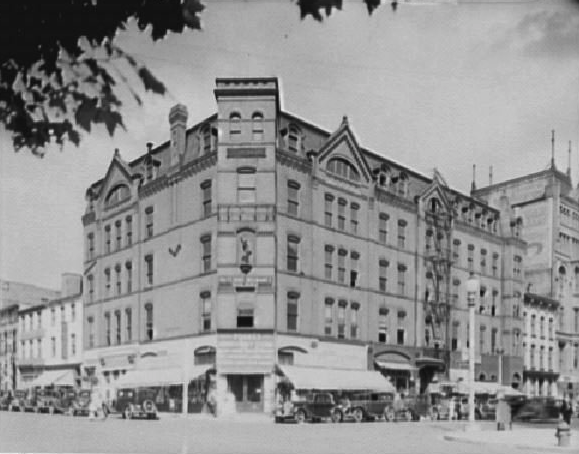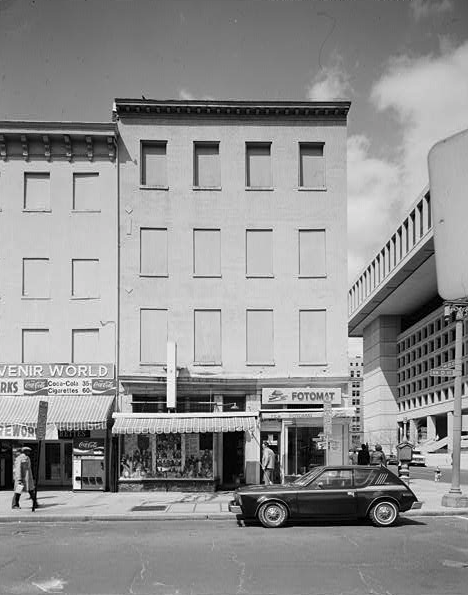Check out what the FBI building site used to look like

The old Criterion Theatre, which sat at the southwest corner of 9th and D Streets. Image by Library of Congress.
Last week, the federal General Services Administration suddenly announced the cancellation of its years-long search for a new FBI headquarters location. As we face the prospect of another decade—and likely longer—with the Hoover Building occupying prime space on Pennsylvania Avenue, it’s worth remembering the site’s past. These photos tell the story.
In the decades before the Hoover Building (bounded by 9th, 10th, and E Streets & Pennsylvania Avenue), the site held a busy and varied streetscape. Here's an aerial shot (looking northwest) circa 1922. Pennsylvania Avenue is in the foreground. Note 900 block of D Street—erased by the Hoover Building—at center:
Image by Library of Congress.
Ignore the ridiculously tiny Ford snowplow in the 1924 photo below. In the background, there's the west half of the 900 block of Pennsylvania Avenue (It lines up with the aerial shot above.)
Image by Library of Congress.
The shot below is from May 8, 1889, looking east from 11th and Pennsylvania, Traders’ National Bank at right (northeast corner of 10th & Pennsylvania) and to its left, a sliver of the Washington Post building. As an aside, the Brentano's on 11th Street was the first branch outpost of the NYC bookseller. Note also the statue of Ben Franklin in the middle of the street at right. (I've written much more on that below.)
Image by Library of Congress.
This shot is from around 1896, looking east along D Street. From right to left, Pennsylvania Avenue, the Traders’ Bank Building at 10th/Pennsylvania, and—at top left—a windmill belonging to the ventilating tower of Ward’s Dairy on D Street:
Image by Library of Congress.
Real-estate atlases show how the FBI site evolved over time. It’s clear from the Baist surveys for 1887, 1892, and 1903 that the area was built up and bustling well before the turn of the century.
Looking at the atlases for 1909, 1913, and 1919, we see the sudden emergence of cinema as a social and economic phenomenon, as theaters pop up in various locations.
Here's the Empress Theatre, 416 9th Street NW, seen here in 1920:
Image by Library of Congress.
And here's the Empress again, this time in July 1939:
Compare those shots with the same location today:
This 1921 image of the Criterion Theatre (on the southwest corner of 9th & D) shows glimpses of nearby D Street businesses as well as the theater’s over-the-top advertising displays:
Image by Library of Congress.
Vaudeville remained popular alongside movies. Here's the “refined” Cosmos (with its fake marble façade) on Pennsylvania dressed up for the March 1917 Inauguration parade:
Image by Library of Congress.
For more on the history of the District’s theatres, see Robert K. Headley’s Motion Picture Exhibition in Washington, DC.
A detail of the earlier aerial shot gives a good view of the Cosmos and Criterion relative to the rest of the block:
Image by Library of Congress.
A glimpse of Pennsylvania’s 900 block (and even a sliver of 10th/D) is visible to the north in this 1929 photo of ironworkers atop the incomplete IRS Building:
Image by Library of Congress.
Above, we saw late-19th century views of the Traders’ Bank Building at 10th/D/Pennsylvania. This image from September 1919—once again looking east along D—shows some changes:
Image by Library of Congress.
For one thing, the bank building has grown by two stories, losing its mansard and dormers in the process. Looking closely, we get another glimpse of the Washington Post building:
(By this point, the Post itself had moved to 1339 E Street NW.)
A similar photo taken only five years later (1924) shows the bank renamed for Ben Franklin (whose statute, recall, stood in front) and the Post building missing its clock tower:
Image by Library of Congress.
The Hutchins Building on the northeast corner of 10th/D, constructed in 1880, was the first purpose-built home of the Washington Post. The building took its name from the Post's founder, Stilson Hutchins, retaining it long after the Post relocated to other premises:
Image by Library of Congress.
Hutchins himself paid for the Benjamin Franklin statue installed at 10th/Pennsylvania just west of the Hutchins Building, which is visible at right in this 1927 photo looking north:
Image by Library of Congress.
This is the same statue currently located at 12th & Pennsylvania in front of the Old Post Office. The Pennsylvania Avenue Development Corporation inexplicably moved it there in 1980 as part of its wholesale overhaul of the avenue.
Just north of the Franklin statue on 10th Street were the offices of the Washington Gas Light Company:
Image by Library of Congress.
For a final look at what occupied the FBI site before the Hoover Building, here's a remarkable 1915 photo looking north along 9th from D Street:
Image by Library of Congress.
Here's a close-up of that photo:
Image by Library of Congress.
You can see a 1914 city directory listing for the block here, and as a reminder, here's how the 400 block of 9th St NW appears today:
None of this is to say that the area was lively and thriving in 1965 when GSA began demolition for the FBI building. On the contrary, much of downtown’s historic building stock was boarded up or even re-faced with new “modern” facades, as seen in this slightly later (1981) photo of the 1000 block of D Street:
Image by Library of Congress.
Still, the District’s downtown has rebounded strongly in recent years, but for obvious reasons the FBI site has not been part of that renaissance. The photos above remind us not only of what the site once held, but what it could be again. Someday.





